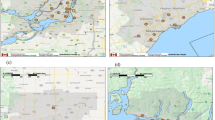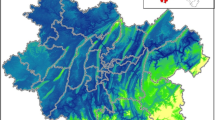Abstract
The risks of exceeding EU limit values for NO2 concentrations have increased in many European cities, and compliance depends strongly on meteorological conditions. This study focuses on meteorological conditions and their influences on urban background NO2 concentrations in the city of Gothenburg for 1999–2008. The relations between observed NO2 concentrations and meteorological conditions are constructed using two modelling approaches: multiple linear regression and synoptic regression. Both approaches assume no trends in emissions over the study period. The multiple linear regression model is established on observed local meteorological variables. The synoptic-regression model first groups days according to synoptic conditions using Lamb Weather Types and then uses linear regression on each group separately. A model comparison shows that linear regression model and synoptic-regression model perform satisfactory. The synoptic-regression model gives higher explained variance (R 2) against observations during the calibration years (1999–2007), in particular for the morning peak and afternoon–evening peak concentrations, but the improvement in the validation period is weak. The annual mean NO2 variations, and their trends during the study period, were assessed using the synoptic-regression model. The synoptic-regression model is able to explain 54%, 42% and 80% of the annual variability of daily mean, morning peak and afternoon–evening peak NO2 concentrations, respectively. The observed and modelled annual means of the daily mean and morning/afternoon–evening peak NO2 concentrations show decreasing trends from 1999 to 2008. All trends, except the trend in annual-average observed morning peak NO2 are statistically significant. The presence of trends in the modelled NO2 concentrations—even though emissions are assumed to be constant—leads us to conclude that weather and climate alone are responsible for a substantial fraction of the recent declines in observed NO2 concentrations in Gothenburg. Favourable meteorological conditions may have mitigated increases in local NO2 emissions during 1999 to 2008.




Similar content being viewed by others
References
Andre, J-M (2005) Vehicle emission measurement collection of the ARTEMIS database. Artemis 3312 report, Available from http://www.inrets.fr/ur/lte/publications/publications-pdf/Joumard/A3312reportJMALTE0504.pdf
Beirle, S., Platt, U., Wenig, M., & Wagner, T. (2003). Weekly cycle of NO2 by GOME measurements: a signature of anthropogenic sources. Atmospheric Chemistry and Physics, 3, 2225–2232.
Bigi, A., & Harrison, R. M. (2010). Analysis of the air pollution climate at a central urban background site. Atmospheric Environment, 44, 2004–2012.
Boersma, K. F., Jacob, D. J., Eskes, H. J., Pinder, R. W., Wang, J., & van der A, R. J. (2008). Intercomparison of SCIAMACHY and OMI tropospheric NO2 columns: observing the diurnal evolution of chemistry and emissions from space. Journal of Geophysical Research, 113, D16S26. doi:10.1029/2007JD008816.
Boersma, K. F., Jacob, D. J., Trainic, M., Rudich, Y., DeSmedt, I., Dirksen, R., et al. (2009). Validation of urban NO2 concentrations and their diurnal and seasonal variations observed from the SCIAMACHY and OMI sensors using in situ surface measurements in Israeli cities. Atmospheric Chemistry and Physics, 9, 3867–3879.
Carslaw, D. C., Beevers, S. D., & Bell, M. C. (2007). Risks of exceeding the hourly EU limit value for nitrogen dioxide resulting from increased road transport emissions of primary nitrogen dioxide. Atmospheric Environment, 41, 2073–2082.
Chen, D. (2000). A monthly circulation climatology for Sweden and its application to a winter temperature case study. International Journal of Climatology, 20, 1067–1076.
Chen, D., Achberger, C., Räisänen, J., & Hellström, C. (2006). Using statistical downscaling to quantify the GCM-related uncertainty in regional climate change scenarios: a case study of Swedish precipitation. Advances in Atmospheric Sciences, 23, 1–7.
Cheng, C. S. Q., Campbell, M., Li, Q., Li, G. L., Auld, H., Day, N., et al. (2007a). A synoptic climatological approach to assess climatic impact on air quality in south-central Canada. Part I: historical analysis. Water, Air, and Soil Pollution, 182, 131–148.
Cheng, C. S. Q., Campbell, M., Li, Q., Li, G. L., Auld, H., Day, N., et al. (2007b). A synoptic climatological approach to assess climatic impact on air quality in south-central Canada. Part II: future estimates. Water, Air, and Soil Pollution, 182, 117–130.
Demuzere, M., Trigo, R. M., Vila-Guerau de Arellano, J., & van Lipzig, N. P. M. (2009). The impact of weather and atmospheric circulation on O3 and PM10 levels at a rural mid-latitude site. Atmospheric Chemistry and Physics, 9, 2695–2714.
Demuzere, M., & van Lipzig, N. P. M. (2010a). A new method to assess air quality levels using a synoptic-regression approach. Part I: present analysis for O3 and PM10. Atmospheric Environment, 44, 1341–1355.
Demuzere, M., & van Lipzig, N. P. M. (2010b). A new method to assess air quality levels using a synoptic-regression approach. Part II: Future O3 concentrations. Atmospheric Environment, 44, 1356–1366.
Flemming, J., Stern, R., & Yamartino, R. J. (2005). A new air quality regime classification scheme for O3, NO2, SO2 and PM10 observations sites. Atmospheric Environment, 39, 6121–6129.
Giorgi, F., & Mearns, L. O. (1991). Approaches to regional climate change simulation: a review. Review of Geophysics, 29, 191–216.
Giorgi, F., & Meleux, F. (2007). Modelling the regional effects of climate change on air quality. Geoscience, 339, 721–733.
Giorgi, F., Hewitson, B., Christensen, J., Fu, C., Jones, R., Hulme, M., et al. (2001). In J. T. Houghton (Ed.), Regional climate information—evaluation and projections, in climate change 2001: The scientific basis (pp. 583–638). New York: Cambridge Univ. Press.
Grice, S., Stedman, J., Kent, A., Hobson, M., Norris, J., Abbott, J., et al. (2009). Resent trends and projections of primary NO2 emissions in Europe. Atmospheric Environment, 43, 2154–2167.
Grundström, M., Linderholm, H. W., Klingberg, J., & Pleijel, H. (2011). Urban NO2 and NO pollution in relation to the North Atlantic Oscillation NAO. Atmospheric Environment, 45, 883–888.
Hanssen-Bauer, I., Achberger, C., Benestad, R., Chen, D., & Førland, E. (2005). Empirical-statistical downscaling of climate scenarios over Scandinavia: A review. Climate Research, 29, 255–268.
Haeger-Engensson, M. (1999). Atmospheric stability and the interaction with local and meso-scale wind systems in an urban area. PhD thesis, Earth Sciences Centre, Gothenburg University, A39.
Haeger-Eugensson, M., Moldanova, J., Ferm, M., Jerksjö, M., & Fridell, E. (2010) On the increasing levels of NO2 in some cities—The role of primary emissions and shipping. IVL Swedish Environmental Research Institute Report B-1886. Available from: http://www3.ivl.se/rapporter/pdf/B1886.pdf.
Jacob, D. J., & Winner, A. D. (2009). Effect of climate change on air quality. Atmospheric Environment, 43, 51–63.
Janhäll, S., Olofson, K. F. G., Andersson, P. U., Pettersson, J. B. C., & Hallquist, M. (2006). Evolution of the urban aerosol during winter temperature inversion episodes. Atmospheric Environment, 40, 5355–5366.
Jenkinson, A. F. & Collison, B. P. (1977). An initial climatology of gales of the North Sea. Synoptic climatology Branch Memorandum, 62.
Kalnay, E., Kanamitsu, M., Kistler, R., Collins, W., Deaven, D., Gandin, L., et al. (1996). The NCEP/NCAR 40-Year Reanalysis Project. Bulletin of the American Meteorological Society, 77, 437–471.
Lam, K. C., & Cheng, S. (1998). A synoptic climatological approach to forecast concentrations of sulfur dioxide and nitrogen oxides in Hong Kong. Environment Pollution, 101, 183–191.
Platt, U. F., Winer, A. M., Biermann, H. W., Atkinson, R., & Pitts, J. N., Jr. (1984). Measurement of nitrate radical concentrations in continental air. Environmental Science & Technology, 18, 365–369.
Pleijel, H., Klingberg, J., & Bäck, E. (2009). Characteristics of NO2 pollution in the city of Gothenburg South-West Sweden– relation to NOx and O3 levels, Photochemistry and monitoring location. Water, Air, & Soil Pollution: Focus, 9, 15–25.
Riemer, N., Vogel, H., Vogel, B., Schell, B., Ackermann, I., Kessler, C., et al. (2003). Impact of the heterogeneous hydrolysis of N2O5 on chemistry and nitrate aerosol formation in the lower troposphere under photosmog conditions. Journal of Geophysical Research, 108(D4), 4144. doi:10.1029/2002JD002436.
Schmidli, J., Goodess, C. M., Frei, C., Haylock, M. R., Hundecha, Y., Ribalaygua, J., et al. (2007). Statistical and dynamical downscaling of precipitation: An evaluation and comparison of scenarios for the European Alps. Journal of Geophysical Research, 112, D04105. doi:10.1029/2005JD007026.
Sen, P. K. (1968). Estimates of the regression coefficient based on Kendall’s tau. Journal of the American Statistical Association, 63(324), 1379–1389.
Spivakovsky, C. M., Logan, J. A., Montzka, S. A., Balkanski, Y. J., Foreman-Bowler, M., Jones, D. B. A., et al. (2000). Three-dimensional climatological distribution of tropospheric OH: Update and evaluation. Journal of Geophysical Research, 105(D7), 8931–8980.
Tang, L., Chen, D., Karlsson, P. E., Gu, Y., & Ou, T. (2009). Synoptic circulation and its influence on spring and summer surface ozone concentrations in Southern Sweden. Boreal Environment Research, 14(5), 889–902.
Thorsson, S., Lindberg, F., Björklund, J., Holmera, B., & Rayner, D. (2011). Potential changes in outdoor thermal comfort conditions in Gothenburg, Sweden due to climate change: the influence of urban geometry. International Journal of Climatology, 31, 324–335.
Velders, G. J. M., & Matthijsen, J. (2009). Meteorological variability in NO2 and PM10 concentrations in the Netherlands and its relation with EU limit values. Atmospheric Environment, 43, 3858–3866.
Vestreng, V., Ntziachristos, L., Semb, A., Reis, S., Isaksen, I. S. A., & Tarrasón, L. (2009). Evolution of NOx emissions in Europe with focus on road transport control measures. Atmospheric Chemistry and Physics, 9, 1503–1520. doi:10.5194/acp-9-1503-2009.
Wetterhall, F., Bárdossy, A., Chen, D., Halldin, S., & Xu, C.-Y. (2009). Statistical downscaling of daily precipitation over Sweden using GCM output. Theoretical and Applied Climatology, 96, 95–103.
Wilby, R. L., & Wigley, T. M. L. (1997). Downscaling general circulation model output: a review of methods and limitation. Progress in Physical Geography, 21, 530–548.
Yue, S., Pilon, P., Phinney, B., & Cavadias, G. (2002). The influence of autocorrelation on the ability to detect trend in hydrological series. Hydrological Processes, 16, 1807–2829.
Ziomas, I. C., Melas, D., Zerefos, C. S., Bais, A. F., & Paliatsos, A. G. (1995). Forecasting peak pollutant levels from meteorological variables. Atmospheric Environment, 29, 3703–3711.
Acknowledgements
This work was supported by the GMV (Centre for Environment and Sustainability, Gothenburg, Sweden) and GAC (Gothenburg Atmospheric Science Centre) foundations. The authors appreciate the assistance of Mr. Jan Brandberg from Environmental Agency in Gothenburg in providing measured meteorological and air quality data for Femman. We gratefully acknowledge the NOAA/OAR/ESRL PSD, Boulder, Colorado, USA, for providing the NCEP Reanalysis data. Finally, we would like to thank an anonymous reviewer for the careful reading and interesting suggestions.
Author information
Authors and Affiliations
Corresponding author
Rights and permissions
About this article
Cite this article
Tang, L., Rayner, D. & Haeger-Eugensson, M. Have Meteorological Conditions Reduced NO2 Concentrations from Local Emission Sources in Gothenburg?. Water Air Soil Pollut 221, 275–286 (2011). https://doi.org/10.1007/s11270-011-0789-6
Received:
Accepted:
Published:
Issue Date:
DOI: https://doi.org/10.1007/s11270-011-0789-6




